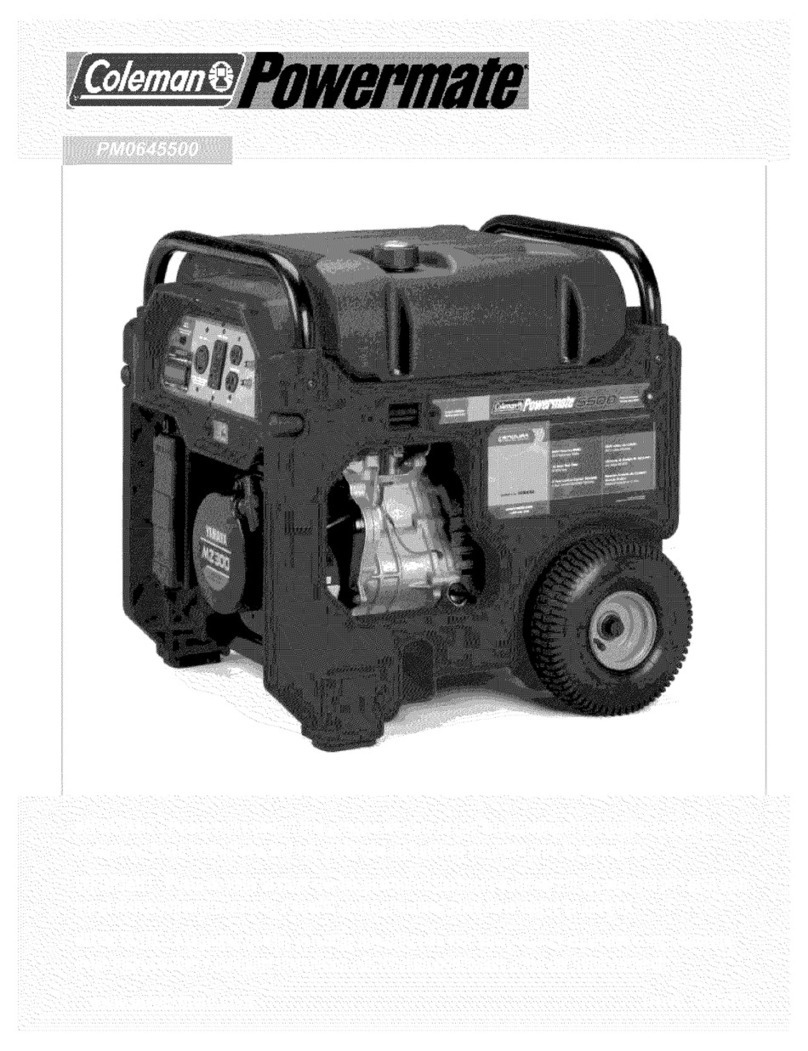
Owner’s Manual for Portable Generator 1
Section 1 Introduction and Safety
Introduction
Read This Manual Thoroughly
If any section of this manual is not understood,
contact the nearest Independent Authorized
Service Dealer (IASD) or Powermate Cus-
tomer Service at 1-800-445-1805, or
www.powermate.com for starting, operating,
and servicing procedures. The owner is
responsible for proper maintenance and safe
use of the unit.
SAVE THESE INSTRUCTIONS for future ref-
erence. This manual contains important
instructions that must be followed during
placement, operation, and maintenance of the
unit and its components. Always supply this
manual to any individual that will use this unit.
The information in this manual is accurate
based on products produced at the time of
publication. The manufacturer reserves the
right to make technical updates, corrections,
and product revisions at any time without
notice.
Safety Rules
The manufacturer cannot anticipate every
possible circumstance that might involve a
hazard. The alerts in this manual, and on tags
and decals affixed to the unit, are not all inclu-
sive. If using a procedure, work method, or
operating technique that the manufacturer
does not specifically recommend, verify that it
is safe for others and does not render the
equipment unsafe.
Throughout this publication, and on tags and
decals affixed to the unit, DANGER, WARN-
ING, CAUTION, and NOTE blocks are used to
alert personnel to special instructions about a
particular operation that may be hazardous if
performed incorrectly or carelessly. Observe
them carefully. Alert definitions are as follows:
NOTE: Notes contain additional information
important to a procedure and will be found
within the regular text of this manual.
These safety alerts cannot eliminate the haz-
ards that they indicate. Common sense and
strict compliance with the special instructions
while performing the action or service are
essential to preventing accidents.
Safety Symbols and Meanings
• If you start to feel sick, dizzy, or weak after
the generator has been running, move to
fresh air IMMEDIATELY. See a doctor, as
you could have carbon monoxide poison-
ing.
(000100a)
Consult Manual. Read and understand manual
completely before using product. Failure to
completely understand manual and product
could result in death or serious injury.
WARNING
(000001)
DANGER
Indicates a hazardous situation which, if not avoided,
will result in death or serious injury.
(000002)
WARNING
Indicates a hazardous situation which, if not avoided,
could result in death or serious injury.
(000003)
CAUTION
Indicates a hazardous situation which, if not avoided,
could result in minor or moderate injury.
DANGER
Using a generator indoors CAN KILL YOU IN MINUTES.
Generator exhaust contains carbon monoxide. This is
a poison you cannot see or smell.
NEVER use inside a home
or garage, EVEN IF doors
and windows are open.
Only use OUTSIDE and
far away from windows,
doors, and vents.
(000103)
DANGER
Asphyxiation. Running engines produce carbon
monoxide, a colorless, odorless, poisonous gas.
Carbon monoxide, if not avoided,
will result in death or serious injury.
Asphyxiation. The exhaust system must be properly
maintained. Do not alter or modify the exhaust system
as to render it unsafe or make it noncompliant with
local codes and/or standards. Failure to do so will
result in death or serious injury.






























